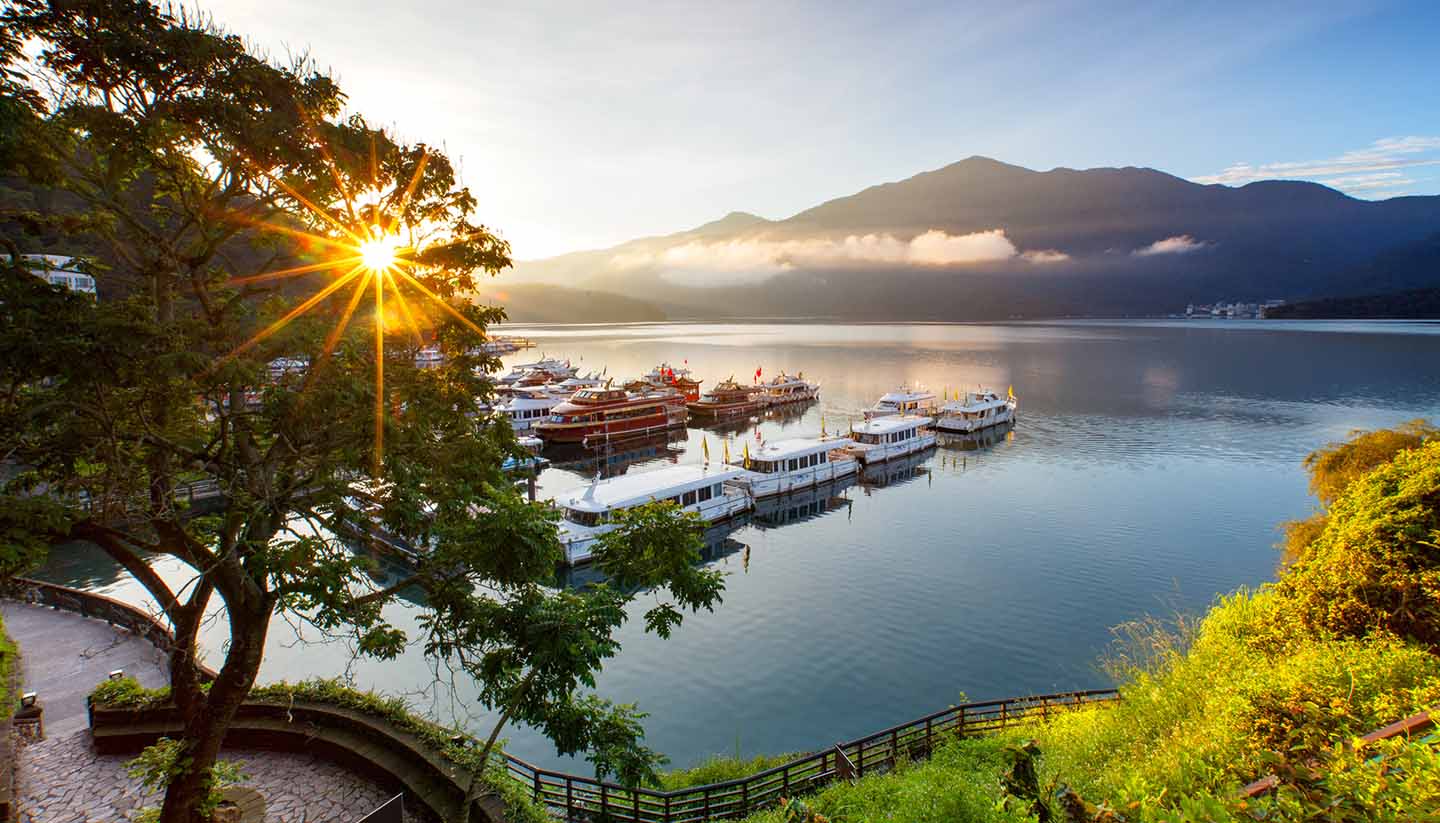Getting Around Taiwan
Air
Taiwan's main domestic airports—such as Taipei Songshan (TSA), Taichung, and Kaohsiung—offer regular flights to outlying destinations like Kinmen, Penghu, Green Island, and Lanyu (Orchid Island). Flights are short, generally under an hour, and operated by local carriers including Uni Air, Mandarin Airlines, and Daily Air.
Road
Domestic travel by road in Taiwan is straightforward, efficient, and scenic. The island's road network is extensive and modern, making it easy to drive between cities or venture into rural and mountainous areas. Whether you're cruising along the dramatic east coast or winding through tea plantations in the central highlands, road travel offers flexibility and a chance to explore at your own pace.
One of the most scenic drives in Taiwan is along the Northeast Coast National Scenic Area, particularly the coastal road between Keelung and Yilan. This route hugs the Pacific shoreline, passing through charming fishing towns, rocky headlands, and sweeping bays. Highlights include Bitou Cape, Longdong's popular rock-climbing cliffs, and the windswept beauty of Fulong Beach.
Side of the road
RightRoad Quality
The quality of Taiwan's roads is generally excellent. National highways and expressways are smooth and well-maintained, with frequent rest stops and clear signage (usually in both Mandarin and English). Even rural roads are in good condition, although they can be narrower and more winding, especially in mountainous regions. It's worth checking local weather reports if you're heading into the hills, as heavy rain or typhoons can occasionally cause landslides or closures.
Road Classification
Taiwan's roads are broadly divided into several categories:
• National Highways (高速公路) – Major motorways, usually tolled, connecting north to south. Known by numbers (e.g. National Highway No. 1).
• Provincial Highways (省道) – Connect cities and towns, often dual carriageways.
• Expressways – High-speed but shorter-distance roads, often urban.
• County and Township Roads – Smaller local roads, often scenic, connecting rural areas and villages.
Car Hire
Car hire is widely available and easy to arrange at airports, major cities, and even some train stations. International companies such as Avis and Hertz operate alongside reliable local providers like IWS and Chailease. Automatic transmission is common, and cars usually come with GPS (sometimes with English-language options). Drivers must be at least 20 years old and have a valid IDP. Petrol stations are plentiful, often full-service, and typically accept credit cards. As in most of the world, Taiwan drives on the right-hand side of the road.
Taxi
Taxis are readily available throughout Taiwan and operate on a standard metered system across the country. They are usually clean and reliable, though drivers may speak limited English outside of major cities. Taxis can be hailed on the street, booked via apps, or found at transport hubs. Fares are affordable by international standards, with surcharges applicable at night or during peak holiday periods.
Ride-hailing services are available. The most widely used platform is Uber, which operates in several major cities, including Taipei, Taichung, Tainan, and Kaohsiung. However, due to local regulations, Uber in Taiwan mostly partners with licensed taxi drivers rather than offering private vehicles. So while you can book a ride via the app, it's often a metered yellow taxi rather than a private car, and pricing typically follows standard taxi fares (plus a small booking fee). Other local ride-hailing apps include LINE Taxi, 55688 (Taiwan Taxi), and Yoxi.
Bike
Touring the island by bicycle has become increasingly popular, with Taiwan Cycling Route No. 1 offering a well-marked circuit around the island. The full loop takes roughly 9 to 12 days and passes through a mix of cities, countryside, and coastal regions. Infrastructure is supportive of cyclists, with repair stations, accommodation geared toward bike travellers, and even luggage transfer services. Major towns and cities offer YouBike, a bike-sharing scheme, and the rail system has dedicated space for bicycles on selected trains. Taiwan takes pride in its cycling culture, bolstered by the success of the homegrown brand Giant.
Coach
Intercity coaches are clean, comfortable, and surprisingly affordable. Major bus companies like Kuo-Kuang, Ubus, Ho-Hsin, and Aloha offer frequent services between all major cities and towns. Coaches typically feature reclining seats, air-conditioning, and extras like free Wi-Fi and USB charging ports. Tickets can be purchased online or at terminals.
Regulations
Speed limits vary: around 50 km/h (31 mph) in urban areas, 60–80 km/h (37–50 mph) on provincial roads, and up to 110 km/h (68 mph) on national highways. Drink-driving is strictly prohibited, with just 0.03% Blood Alcohol Concentration. Seat belts are mandatory for all passengers, front and back, and using a mobile phone while driving is only allowed with a hands-free device. City driving requires extra attention, particularly due to the high number of scooters weaving through traffic.
Breakdown services
Car hire companies often provide island-wide roadside service and replacement vehicles within 24 hours.
Documentation
Foreigners wishing to drive in Taiwan must carry an International Driving Permit (IDP) issued under the 1949 Geneva Convention and a valid licence from their home country. Some nationalities may also need an official Chinese-language translation of their licence, which can be arranged through their embassy or local vehicle offices.
Visitors staying long-term can apply for a Taiwanese driving licence, either through a reciprocal agreement or by taking a local test, depending on nationality.
Urban travel
Getting around Taiwan's cities is easy, efficient, and remarkably affordable. Taipei and Kaohsiung both have modern, clean, and well-signposted metro systems (MRT) that connect key attractions, business districts, and residential areas. Trains are frequent, air-conditioned, and run on time, making them the preferred choice for locals and visitors alike. Stations usually have signage in both Chinese and English, and journeys can be paid for with a stored-value EasyCard or iPASS, which also works on buses, YouBikes, and even in convenience stores.
In cities without a metro, such as Taichung, Tainan, and Hualien, buses form the backbone of public transport. While bus networks are extensive, routes can be confusing for newcomers, so using a transport app (like Google Maps or local services) is helpful. Fares are low, and EasyCards are accepted in most regions.
Taxis are widely available in urban areas and are relatively inexpensive by international standards. They run on meters, and tipping is not required. Some drivers may speak limited English, so having your destination written in Chinese—or using a map app—can be useful.
Ride-hailing services are available. The most widely used platform is Uber, which operates in several major cities, including Taipei, Taichung, Tainan, and Kaohsiung. However, due to local regulations, Uber in Taiwan mostly partners with licensed taxi drivers rather than offering private vehicles. So while you can book a ride via the app, it's often a metered yellow taxi rather than a private car, and pricing typically follows standard taxi fares (plus a small booking fee). Other local ride-hailing apps include LINE Taxi, 55688 (Taiwan Taxi), and Yoxi.
For short trips or a leisurely pace, many cities have bike-sharing schemes such as YouBike, with docking stations near MRT stops and major landmarks. Roads often have designated cycle lanes, especially in Taipei and Taichung, making urban cycling a safe and pleasant option.
Rail
Taiwan's rail network is one of the most convenient ways to travel around the island. The system includes the efficient Taiwan High-Speed Rail (THSR), which runs along the western corridor from Taipei to Kaohsiung, cutting travel time to under two hours.
In addition, the Taiwan Railways Administration (TRA) operates a more extensive network serving cities, towns, and rural areas. TRA trains range from fast expresses to scenic slow trains that wind along the east coast or through mountainous regions. Stations are generally well signposted, tickets can be reserved in advance or bought at vending machines, and trains run punctually—a real plus for travellers on a schedule.
Popular rail routes in Taiwan include:
• Taipei to Kaohsiung (via High-Speed Rail – THSR). This is the backbone of high-speed travel in Taiwan and is fast, clean, and reliable. Major stops include Banqiao, Taichung, Chiayi, and Tainan.
• Taipei to Hualien (via Taiwan Railways – TRA). This route hugs the dramatic northeast coastline before cutting through to the east. The journey offers lovely sea views and access to attractions such as Taroko Gorge, one of Taiwan's natural highlights.
• Hualien to Taitung (East Coast route – TRA). This is one of the most scenic train rides in the country, passing through rice paddies, the East Rift Valley, and coastal cliffs. It’s slower and more relaxed than the western routes, and perfect for travellers exploring rural Taiwan, hot springs, or aboriginal villages.
• Taipei to Tainan (via THSR or TRA). A great route for history buffs. You can take the high-speed train (about 1.5 hours) or a slower, more scenic TRA train. Tainan is Taiwan's oldest city and former capital, filled with temples, old forts, and fantastic street food.
• Pingxi Line (branch line from the main TRA network). This charming rural line east of Taipei is famous for its nostalgic feel and scenic mountain towns like Shifen and Pingxi, which are known for old mining villages, waterfall hikes, and sky lanterns. It's a leisurely half-day or full-day trip from Taipei.
• Alishan Forest Railway. Although not part of the main TRA network, this historic narrow-gauge railway climbs through misty forests from Chiayi to Alishan. It's a beautiful and slow-paced ride through Taiwan's mountainous interior and one of the few remaining forest railways in the world.
Water
Regular ferry services connect the main island to popular offshore destinations such as Penghu, Kinmen, Matsu, Green Island, and Lanyu (Orchid Island). These routes are popular with both locals and tourists, especially during the holiday season.
Ferries vary in size and speed, and most operate from ports such as Kaohsiung, Taitung, Hualien, and Keelung. For example, ferries from Taitung serve both Green Island and Lanyu, while routes from Kaohsiung head to the Penghu archipelago.
Schedules can be affected by weather conditions, particularly during typhoon season or in winter when seas can be rough, so it's wise to check ahead and book tickets in advance when possible. Some ferries also carry scooters or bicycles, making it easier to explore the islands once you arrive.


